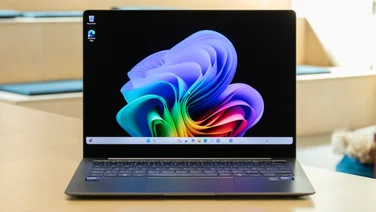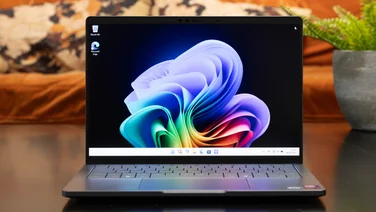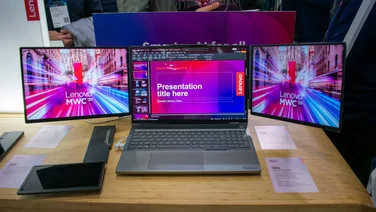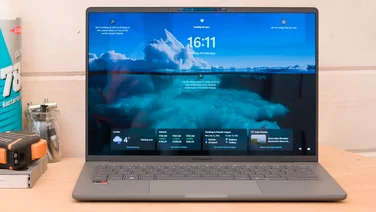To help us provide you with free impartial advice, we may earn a commission if you buy through links on our site. Learn more
- Lenovo ThinkPad X1 Yoga (2018) review: What you need to know
- Lenovo ThinkPad X1 Yoga (2018) review: Price and competition
- Lenovo ThinkPad X1 Yoga (2018) review: Design
- Lenovo ThinkPad X1 Yoga (2018) review: Keyboard and touchpad
- Lenovo ThinkPad X1 Yoga (2018) review: Display
- Lenovo ThinkPad X1 Yoga (2018) review: Performance and battery life
- Lenovo ThinkPad X1 Yoga (2018) review: Verdict















- Nifty security features
- Superfast SSD speeds
- Excellent connectivity options
- Ultra-bright, vivid touchscreen
- CPU could be faster
- Gets very, very warm
- Hugely expensive for top-specs
Lenovo’s ThinkPad line is a bit of an institution. It’s been a guiding light for security-conscious business laptops for over two decades now, with top-notch performance to get the job done. Lenovo’s Yoga line, though more recent, has also earned a reputation of its own, changing the game for the 360-degree laptop.
And then there’s the ThinkPad Yoga. Now in its third generation, it’s a powerful crossbreed between Lenovo’s two most well-known laptops. This latest iteration of the ThinkPad/Yoga fusion packs some serious hardware heat, but is it really worth all that money?
READ NEXT: Lenovo Yoga C930 review
Lenovo ThinkPad X1 Yoga (2018) review: What you need to know
Lenovo ThinkPad laptops are formidable (and expensive), business-grade ultraportables known for heavy-duty specs and an abundance of connectivity options. Yogas, on the other hand, are famous for being lightweight, portable devices with 360-degree hinges and touch-sensitive screens. The Lenovo ThinkPad X1 Yoga is, as Hovis might say, the best of both.
The model I’m reviewing here is the Lenovo ThinkPad X1 Yoga, which is fitted with a 14in touchscreen display at a resolution of 2,660 x 1,440. An Intel Core i7-8550U CPU powers things, along with 16GB of RAM and 512GB of PCIe NVMe SSD storage.
Lenovo ThinkPad X1 Yoga (2018) review: Price and competition















Here’s where the ThinkPad X1 Yoga becomes a tough sell. The exact configuration tested in this review will set you back a wallet-crushing sum of £1,871.
It gets even more expensive, however, if you decide to upgrade the CPU to an Intel Core i7-8650U chip and whack on a massive 1TB of storage for good measure. This particularly beefed-up setup will set you back a whopping £2,217.
Perhaps you don’t fancy dropping upwards of £2,000 on a new laptop? In which case, you could splurge on the entry-level configuration of the ThinkPad X1 Yoga for £1,360. That’ll get you an Intel Core i5-8250U, a Full HD screen, 8GB of RAM and 128GB of storage. Plus the three-year “Think” warranty, which you get when you buy any ThinkPad via the Lenovo website.
There are other options besides the ThinkPad, of course. Microsoft’s new Surface Laptop 2, reviewed at £1,249, is a stylish 2-in-1 that’s alarmingly speedy for its size. If you’re craving raw performance, though, it’s hard to beat Dell’s XPS 15 2-in-1 (£1,699) as its battery life and processing speeds are most impressive.
Buy the Lenovo ThinkPad X1 Yoga now from Lenovo
Lenovo ThinkPad X1 Yoga (2018) review: Design















As much as I like to avoid generalising, ThinkPads tend to look identical. In most cases, if you’ve seen one, you’ve seen them all. The X1 Yoga continues this trend, and while its design is far from revolutionary, a few subtle tweaks have been added.
The ThinkPad X1 Yoga can now be picked up in silver, for starters, which offers a nice alternative to the classic matte black chassis so synonymous with the ThinkPad range. The body materials are much the same as its other ThinkPad contemporaries, though: carbon, glass, plastic and magnesium combine to make for a sturdy – but not too heavy – chassis. The laptop tips the scales at only 1.4kg and measures 33 x 229 x 17mm.















If it weren’t for the touchscreen and the 360-degree hinge, I wouldn’t be able to tell this laptop apart from the ThinkPad X1 Carbon I reviewed recently. Both include nice grippy surfaces that are perfect for carrying around, and the reversible hinge fitted under the screen works beautifully well, rotating smoothly to your desired viewing angle.
Like previous ThinkPad devices, the X1 Yoga has a powered stylus that slots into the right-hand edge of the base. The relatively small pen is made of plastic and does feel rather flimsy, although it’s nice and responsive. Crucially, however, it’s included at no extra cost.















The webcam shutter is the most welcome new feature, which can quickly block out the laptop’s camera with a small slider situated above the screen. A basic security requirement, yes, but many other business-focussed ultrabooks fail to deliver on this front. Offering even more security points, the ThinkPad X1 Yoga has a fingerprint reader located to the right of the trackpad.
Connectivity options, as with all ThinkPads, are as good as you’d expect from a premium business laptop. On the left edge, you’ll find two USB-C ports (the charger plugs into either of these) which are both Thunderbolt 3-enabled. There’s also a full-fat USB 3.0 connector.















There’s an HDMI 2.0 slot on the right, along with another USB 3.0 port, Ethernet port and 3.5mm audio jack. The power button is also on this same edge. With the lid closed, you can open up a small hatch tucked away on the back edge, which reveals a nano-SIM slot and microSD reader.
The Dolby Audio-branded speakers are fitted on the underside of the laptop, but audio doesn’t sound muffled when placed on a flat surface. Crank the volume up to max and the speakers are perfectly loud enough to fill a large room with a Mozart concerto.
Lenovo ThinkPad X1 Yoga (2018) review: Keyboard and touchpad















You know what you’re in for when it comes to a ThinkPad keyboard, and the X1 Yoga’s typing experience is no exception. Travel and feedback are excellent, producing a satisfying clicky sound, and the chiclet-style keys are subtly curved to improve comfort. It’s a joy to type on.
One complaint, which I also aired in my ThinkPad X1 Carbon review, is the placement of the PgUp and PgDn keys. These two keys sit very close to the left and right of the arrow keys and are irritatingly easy to press accidentally.















Another problem is heat. This was a minor issue with the ThinkPad X1 Carbon, but with the X1 Yoga, the upper base of the laptop became worryingly warm during some of our demanding benchmarking tests. Using an IR thermometer gun during one test, I found that the upper base had reached a high of 56°C. During another test, Core Temp showed an average CPU temperature reading of 90 degrees Fahrenheit. When it’s this hot, it’s actually uncomfortable to touch the top few rows of the keyboard.
The red TrackPoint, fitted between the G, H and B keys, remains a core component of the X1 Yoga’s design. I don’t really use it myself, but this is a legacy feature that many would miss if it disappeared. The TrackPoint’s sensitivity settings can also be adjusted, which is great for accessibility.















Although I could get used to the TrackPoint if forced, I much prefer the excellent touchpad. I never once experienced any problems with accuracy – it moves the cursor with perfect precision and has a lovely texture, too. Unlike most laptops, the left and right click button are above the trackpad rather than below it.
Buy the Lenovo ThinkPad X1 Yoga now from Lenovo
Lenovo ThinkPad X1 Yoga (2018) review: Display















This particular ThinkPad X1 Yoga arrived with the top-spec 14in IPS touch-enabled display, with a resolution of 2,560 x 1,440. Lenovo says the screen offers “500nit brightness” and “complete” colour gamut coverage, but does it live up to its marketing-heavy product description?
Mostly, yes. Our display calibration tests revealed a sRGB colour gamut coverage of 99.6%, which is pretty much perfect – with a cheeky spot of rounding up. The gamut volume of 150% is less so – colours on screen are massively oversaturated, as an average Delta E measurement of 3.87 made clear. The display still looks fantastic, but it isn’t really suitable for colour-sensitive image and video-editing tasks.
Lenovo isn’t kidding about the laptop’s brightness, though. A maximum luminance of 516cd/m² is retina-blindingly good and, of all the laptops I’ve reviewed recently, is second only to the ThinkPad X1 Carbon.
Lenovo ThinkPad X1 Yoga (2018) review: Performance and battery life
Considering how much it costs, and based on my experiences with other ThinkPad laptops, the X1 Yoga’s performance isn’t anything special. Especially given that it packs the same Kaby Lake R Intel Core i7-8550U CPU and 16GB of RAM as the ThinkPad X1 Carbon, which was much faster.

As you can see, the X1 Yoga’s combined benchmark score of 59 is easily outclassed by its competitors and I suspect the laptop’s heat issues is the likely culprit. In comparison, the Surface Laptop 2, equipped with an Intel Core i5-8250U, is much faster – it scored 84 in the media benchmark test – and costs a lot less.

Business-grade laptops need to be equipped with speedy SSDs and, in this department, the ThinkPad X1 Yoga excels. With read and write speed scores of 2,246 and 1,750 in the AS SSD file sequencing benchmark, the beastly 512GB PCIe NVMe SSD steams through files like a tech journalist with a sharing pack of Oreos.

It’s less formidable as a gaming device, unfortunately. Then again, that’s not really what you’re buying it for, but the ThinkPad X1 Yoga’s integrated Intel UHD 620 Graphics isn’t up to snuff for capably running Triple-A titles. It handled the GFXBench Manhattan on-screen benchmark easily enough, averaging 36.6fps, so it holds its own against the X1 Carbon and Surface Laptop 2 at the very least. The Metro: Last Light benchmark is far more demanding, however, and merely averaged 8.6fps at Full HD resolution.

The ThinkPad X1 Yoga’s battery life could be better, too. Reaching 6hrs 3mins in our continuous video playback test, battery levels plummeted to zero two-and-a-half hours sooner than the XPS 15 2-in-1. If you’re planning to use it on a long-distance flight, make sure to get it fully charged before you hop on the plane.
Buy the Lenovo ThinkPad X1 Yoga now from Lenovo
Lenovo ThinkPad X1 Yoga (2018) review: Verdict















Fusing the ThinkPad with the Yoga was a cracking idea and the result is a formidable business laptop that doubles up as a flexible entertainment device. It has its problems, namely excessive CPU heat and poor battery life, but on the whole, it’s a perfectly competent multi-purpose machine.
Throw in a long list of connectivity options, excellent security features and solid build quality, and I’d recommend the ThinkPad X1 Yoga to anyone looking for a business laptop with a twist – the 360-degree hinge and touch-enabled display make for a staggeringly versatile device.





